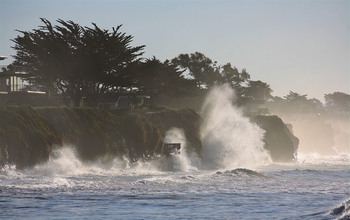
Research News
Wet and dry seasons linked with public health threats in sub-Saharan Africa
November 9, 2018
Find related stories on NSF’s Environmental Research and Education (ERE) programs at this link.
In sub-Saharan Africa, diarrheal disease, a preventable and treatable illness, remains the second-leading cause of death in children under the age of five, as well as an overall public health threat.
Now, researchers have uncovered a connection between the water in rivers and vulnerability to the disease.
Scientists Kathleen Alexander of Virginia Tech and Alexandra Heaney and Jeffrey Shaman of Columbia University conducted research on the influence of flooding on disease along the Chobe River floodplain in northern Botswana.
The results of their study, funded by the National Science Foundation (NSF), were published this week in the journal PLOS Medicine.
In southern Africa, climate change is predicted to increase the frequency of extreme events such as drought and floods, suggesting that people will be more vulnerable to waterborne disease.
“These new results show the complex relationships among people and the water cycle in regions with pronounced wet and dry seasons,” said Richard Yuretich, a director of NSF’s Dynamics of Coupled Natural and Human Systems program, which funded the research.
“The pattern of disease associated with changes in the volume and quality of water can help in designing water treatment systems that are responsive to the natural ebb and flow of the environment.”
The study was focused on communities that rely on water in the Chobe River floodplain. This river system, like others in Africa, has floods that are highly variable, both seasonally and from year to year.
The researchers wanted to know whether changing water levels are contributing to disease outbreaks, and how climate change, predicted to increase flooding and hydrologic variability, might increase disease vulnerability.
Despite the presence of a centralized water treatment infrastructure in the region, disease outbreaks continue in a regular pattern there.
“These places are doing everything right,” Alexander said, “but local populations are still affected by disease. Why does the infrastructure fail to protect these communities, and what can we do to improve public health in this and other regions now and in future environmental conditions?”
In partnership with the government of Botswana, the researchers evaluated disease outbreak patterns across eight villages and towns along the Chobe River, using decades of data from 11 government health facilities.
The scientists evaluated the data in conjunction with detailed hydrometeorological conditions, including bimonthly water quality studies that spanned nearly a decade.
They discovered that increases in disease were closely tied to periods of rainfall, with a 3-foot drop in river height in the dry season linked with a staggering 16.7 percent increase in diarrheal disease in children under the age of five.
Various age groups were affected differently by season, with children aged one to four experiencing more illness in the wet season, and older children and adults reporting more sickness in the dry season.
“What this tells us is that environmental conditions drive the disease — not just the number of cases and timing of outbreaks, but who is affected and what type of illness might occur,” said Alexander.
Overall, adults and children were equally affected, suggesting that in populations such as those in northern Botswana, an expansion of disease surveillance and intervention strategies may be needed.
While flooding of a region is often associated with disease outbreaks, it was the draining of water off the flood plains back into the river channel that was most closely tied to diarrheal disease in this study.
The researchers hypothesize that extreme variability in water conditions linked with annual rainfall and floods may compromise water treatment facilities.
“Highly variable water dynamics are difficult to manage in many water treatment plants, potentially increasing waterborne disease risk,” said Alexander, who is a veterinarian.
“There is an urgent need to evaluate water infrastructure and to ensure that these systems are able to handle rapid shifts in water quality.”
A single scale of study is often inadequate to understanding today’s complex problems, she said. “Public health research must look beyond the patient, engaging multi-scale and multidisciplinary approaches that span the human-environmental interface.”
Additional support for the research came from the Empowerment of Non-State Actors Programme, a joint partnership between the government of Botswana and the European Union.
—
Cheryl Dybas,
NSF
(703) 292-7734 cdybas@nsf.gov
-
When floodplains go dry, disease outbreaks occur as the waters recede into the main river channel.
Credit and Larger Version -
Scientists collect samples from the Chobe River for water quality assessments.
Credit and Larger Version -
Water-related disease is a growing threat to children under five in sub-Saharan Africa.
Credit and Larger Version -
Elephants share the Chobe River floodplain with the human residents of the area.
Credit and Larger Version -
Sunset over the Chobe River. Its future and that of people living along its floodplain are linked.
Credit and Larger Version
Related Programs
Dynamics of Coupled Natural and Human Systems
Related Websites
NSF Discovery: Land cover change in Botswana savannas: Don’t blame the elephants: https://www.nsf.gov/discoveries/disc_summ.jsp?cntn_id=243594
NSF Discovery: Human Disease Leptospirosis Identified in New Species, the Banded Mongoose, in Africa: https://www.nsf.gov/news/news_summ.jsp?cntn_id=127914














